PLEASE NOTE: Our ongoing efforts to check in with travelers who are currently overseas, in accordance with our promise to monitor their trips, does not mean we advocate travel during the COVID-19 pandemic. On March 11, the U.S. State Department advised U.S. citizens to reconsider travel abroad, and non-U.S. citizens were banned from flying from Europe to the U.S. for at least 30 days. Public health officials advise older adults and people with underlying health conditions to abstain from travel entirely. They also recommend “social distancing” for everyone, which means keeping about six feet of space between yourself and others, which is hard to do on planes or trains and in airports. For any travelers returning from a country with a widespread outbreak, the CDC is advising self-quarantines.
In our continuing effort to touch base with those who are traveling internationally now, we are interviewing readers who are currently overseas. Although we are speaking with them at the moment they are abroad and publishing as quickly as possible, we realize that the situations in those locations and around the world are changing quickly, and therefore travel alerts, health advisories, and even these travelers’ opinions may soon be different.
We’re thankful to Janette Gill and her family for sharing their story, and for continuing to share as world events and travel rules have changed over the past few weeks. We have added updates from Mrs. Gill throughout her trip.
The Gills’ travel timeline (Rome–Norway–Barcelona–Porto–Lisbon):
Mrs. Gill’s travels began on February 26, when she flew to Italy to spend time with her college-age daughter, who was studying in Rome this semester. After a mother-daughter jaunt to Norway, their plan was to return to Rome and meet up with the rest of the family—Mrs. Gill’s husband and younger daughter—for an Italian spring break planned by Andrea Grisdale, one of Wendy’s WOW List trip-planning specialists based in Italy.
Then Italy’s coronavirus count exploded. The day before Mrs. Gill arrived in Rome, 11 towns in Lombardy went on lockdown, and Milan closed its schools, the Duomo Cathedral, and the La Scala opera house after the reported cases surged from five to more than 150. Mrs. Gill and her daughter were much farther south, touring Rome and monitoring the situation. By the time they flew to Norway on February 28, the number of Italian cases had hit 800 and the CDC and State Department gave Italy a Level 3 travel alert (reconsider travel). The very next day, northern Italy was bumped up to Level 4 (do not travel). The Gill family had to rethink their trip.
Instead of scrapping their vacation, they changed their destination. While in Norway, Mrs. Gill and her older daughter researched their options and decided on Spain and Portugal, where the viral infections were much lower (at that time, fewer than 400 in Spain and only nine in Portugal) and the travel alerts were not prohibitive (level 1 in Portugal; Spain is still at level 2 for political unrest in October 2019). Of course, the pandemic continued to spread, and on March 11, President Trump announced a travel ban, prohibiting non-citizens from 26 European countries from entering the U.S.; Portugal and Spain are on that list.
The first time we interviewed Mrs. Gill, she was in Norway on March 3. We talked about her experiences, thoughts, and decisions about traveling during the coronavirus outbreak. We emailed with her again when she and her older daughter landed in Spain on March 6 to meet up with her husband and younger daughter. We spoke again on the phone on March 10 after they had driven from Porto to Lisbon. On March 13, she emailed us again from Lisbon with a final update, as she and her family prepared to board a flight home from Portugal (their regularly scheduled flight).
Update March 13, from Lisbon:
Via email: “Since we were not able to change our flights to travel home a day earlier yesterday, we decided to make the most of being in Portugal by being outdoors (still lots of hand washing and sanitizer). There were still a handful of tourists visiting the quaint seaside town of Sintra and driving along the beautiful coastline near Lisbon. Locals were out shopping, eating in cafes, and playing at the beach since school had been canceled.
Our tour guide this morning told us that the Prime Minister of Portugal “has now invited everyone to a volunteer quarantine,” and I’m hopeful that the locals can get back to their normal lives very soon.
In order to be a good citizen to my neighbors and family, I plan on self-quarantining when we arrive home, to help prevent the possible spread of this virus.
Even though the past 2 1/2 weeks of traveling through several countries in Europe has sometimes been challenging, with schedule changes and the unknown of what the next day would bring, I must say that the locals have done their best to accommodate us by adjusting our itinerary. I know their economy will suffer from the decrease in foreign tourists, but I have no doubt that they will bounce back in time even stronger.
Kudos go out to Andrea Grisdale and her team for postponing our trip to Italy until next year.”
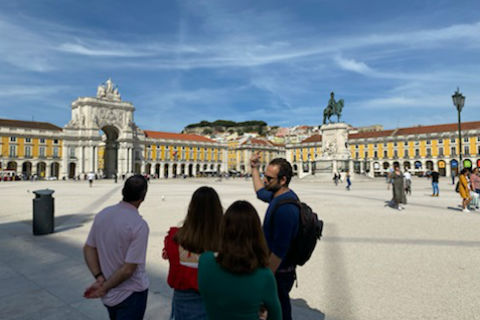
The Gill family with their guide in Lisbon’s Praca do Comercio. Photo courtesy of the Gill family
Update March 10, from Lisbon:
When we spoke on the phone with Mrs. Gill on March 10, she and her family had just driven from Porto to Lisbon. She noted that when she flew from Rome to Barcelona and then from Barcelona to Porto, neither airport was checking temperatures. “It surprised us,” she said. She also said that the airplanes were about three-quarters full and the airports seemed busy.
Despite the coronavirus seeming to take over news here, they were enjoying themselves. On Monday, they had toured the Douro Valley with a guide and ran into some other American travelers. “On our little gondola ride across the water, there were a group of three Syracuse students that were studying in London and were on their spring break. They said they had to be careful where they traveled to because the university told them not to travel to certain countries. A couple from New York was there and they were having a great time.”
Mrs. Gill has had a few experiences that reflect the uptick in coronavirus concerns. When she contacted a guide to schedule a day trip from Lisbon to Sintra, the guide declined, saying she is ten weeks pregnant and her doctor advised her not to lead tours right now. And when the family checked into their Airbnb in Lisbon, their host contacted them to say she would not be meeting them in person because of the virus. “So there were two incidents when the locals were keeping themselves safe,” Mrs. Gill said. Still, she added, “I’ve only seen a handful of masks, and people don’t seem to really be talking about it.” This morning, she said, they’d walked down to the port and around the harbor, and then visited the popular Livraria Lello, the bookstore that inspired J.K. Rowling’s vision of Harry Potter’s Hogwarts. As usual, it was busy to get in. “There was a line, but they had hand sanitizer at the door.”
We asked her if her feeling about traveling, or letting her daughter travel, had changed at all. She answered, “I don’t think it’s really changed. I think it’s just that we need to stay informed before my daughter travels. She needs to stay informed of what’s going on and which areas she shouldn’t travel to. She will have been two weeks from Rome by the time she gets home. If she came back with us she would have to self quarantine. But she’ll be in Dublin for a week so she won’t have to; it’s from the day you leave the country.”
Update March 6, from Barcelona:
Mrs. Gill landed in Barcelona on March 5, after transiting through Rome, and she emailed us March 6 with an update. Much had changed in the short time she was away from Italy; the number of cases was now more than 4,000. “I must say that I can now see how this is affecting the Italians,” she wrote. On the flight over, the Alitalia staff member who checked her in expressed concern that the company might go under because of the virus. She said: “Also, I sat next to a young Italian woman who lives in Barcelona who had been visiting her family outside of Rome. She mentioned that taxis that day in Rome were begging for passengers, restaurants they ate in were deserted, and roads were empty (which never happens). It’s all very sad for their people and economy.” Mrs. Gill added that she was surprised that no one at the Barcelona airport took her temperature when she arrived. And she included a photo, taken by her husband, of his empty flight from Newark to Rome, where he and their younger daughter flew before their connection to Barcelona.
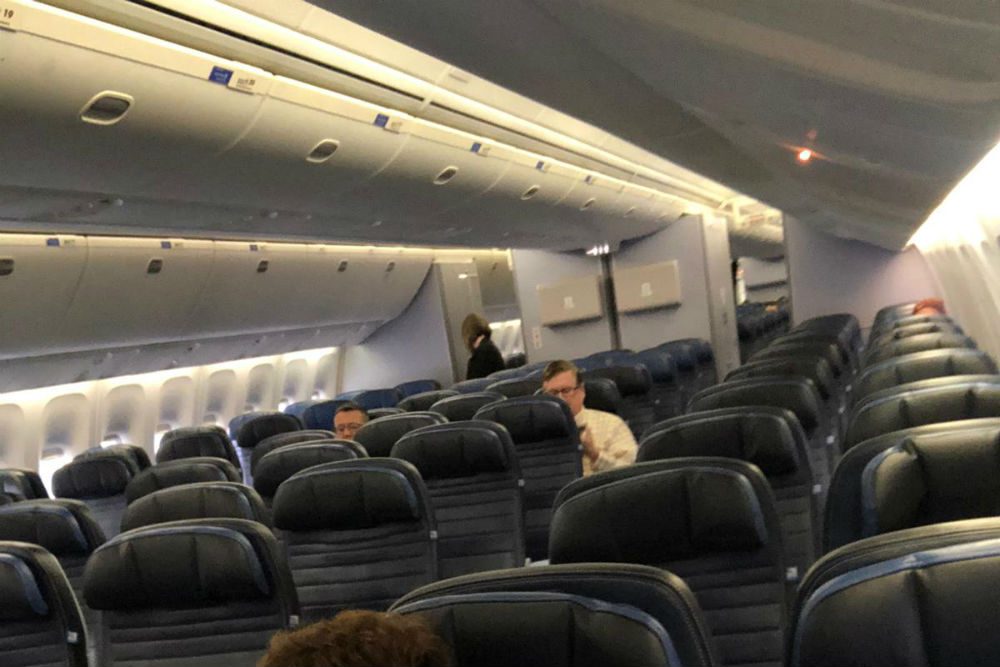
Mr. Gill’s empty flight from Newark airport to Rome on March 6. Photo courtesy of the Gill Family.
The Gills took this video of the line at Parc Guell in Barcelona on March 7:
Original interview on March 3, from Norway, after Rome:
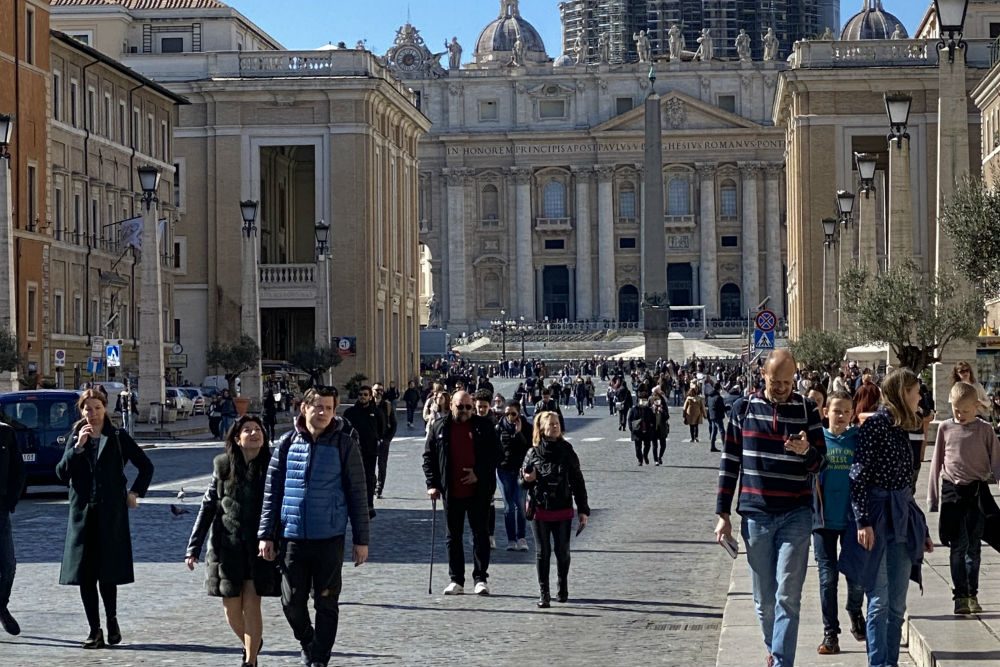
The streets in Rome were still full of tourists on the last weekend of February, and not many were wearing masks.
Q: Your main concern was not getting sick but getting stuck?
A: Yes, my husband didn’t want to get stuck. He said, I don’t want to be quarantined if we come back from Italy and they’ve raised all of Italy to Level 4.
And, just as my oldest daughter and I were headed to Norway, she got an email from her university that they were canceling the semester in Rome and they would do all their classes online. So now our family is planning to meet in Barcelona [on March 6] for a few nights and then go on to Portugal [March 8–13].
Q: You spent time in Rome February 26–28. What was that like?
A: I spent two nights in Rome with my daughter, and we felt perfectly safe. I washed my hands a lot and did what you normally do when you travel so you don’t get sick. I’d brought extra sanitizer and wipes and things like that to wipe down the airplane seat and tray. But other than that, we felt safe in Italy.
Q: How did the virus situation affect what you did in Italy?
A: It was fine. There were very few people with masks on. We went to the Vatican and the Sistine Chapel. We made sure to wash our hands a lot. But other than that it was business as usual. My daughter thought the lines to get into the Vatican were less crowded than usual, but there were still lines. They weren’t wrapped around the building anymore, but there were lines. We met up with some of her roommates for dinner, and the restaurant scene was packed. To me, I wouldn’t have noticed anything going on, and the Italians that we spoke with didn’t seem too concerned.
Then we went to the airport. There wasn’t a fear. It was just that if someone coughed, you stepped away. There was hand sanitizer at the baggage claim and desk, but I don’t know if that’s always there. When I’d arrived at the Rome airport from the U.S., they were screening for temperatures. When we took a train from the Rome apartment to the airport to fly to Norway, there were signs up at the train station and on the train. There were also signs in the Norway airport.
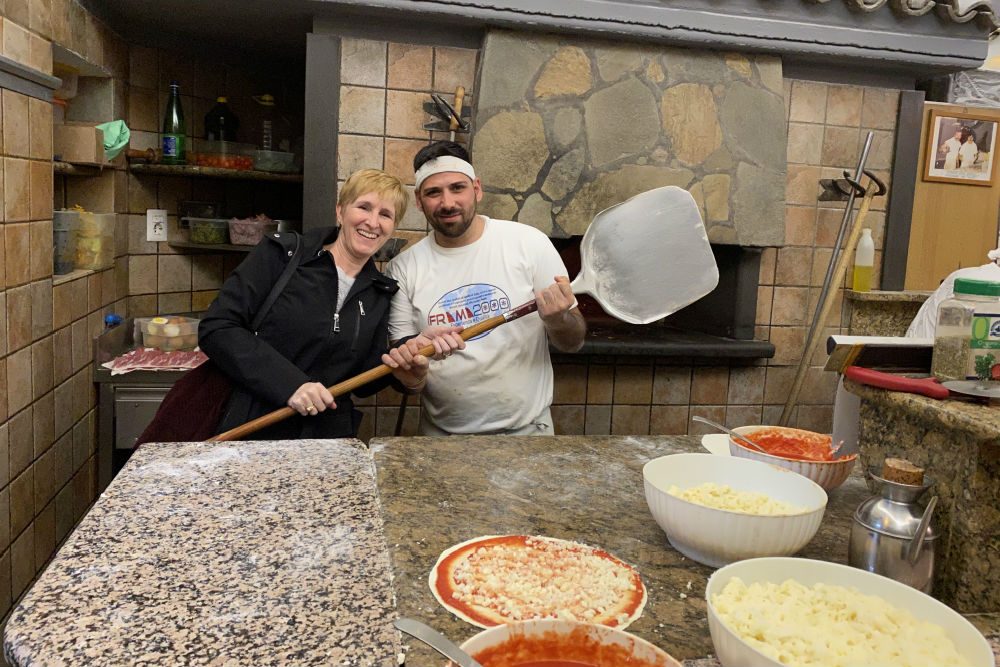
Mrs. Gill said her trip to Rome and Norway felt “the same as other trips, but with more hand sanitizer.” Photo courtesy of the Gill Family.
Q: You’ll need to transit through Rome so your daughter can get her stuff there. Are you concerned?
A: I wasn’t fearful to be in Rome; my only fear was returning to the U.S. and what the U.S. government would impose on us. At my daughter’s [home] university, it’s mandated that students traveling back from the Rome program must self-quarantine for two weeks before they go back to campus. Seeing that come from the university, my husband said, ‘I don’t want to go to Italy because when we come back I don’t want to be self-quarantined for two weeks.’ [Update: When Mrs. Gill and her daughter flew back to Rome after Norway, she remained in the airport in order to avoid being subject to self-quarantine in the United States; her daughter would be traveling through Europe for a few more weeks and therefore would no longer be required to self-quarantine.]
Q: How expensive or difficult was it to cancel your Italy trip?
A: Andrea Grisdale was fabulous: She worked with us and enabled us to postpone our trip and save almost all of our money. We will come back to Italy before the end of the year; we’re just not sure when. Andrea has also been good about sharing information on how many people in Italy who got the virus have already recovered. It gave me a sense of comfort to know that a lot of the people who were affected have already been cleared.
Q: What does it feel like in Norway? How are they addressing the coronavirus for travelers?
A: At the last two hotels we stayed at, there was lots of hand sanitizer everywhere, and we did see a few signs. Every restaurant has hand sanitizer when you walk in. I don’t know if that’s normal, but I did see it.
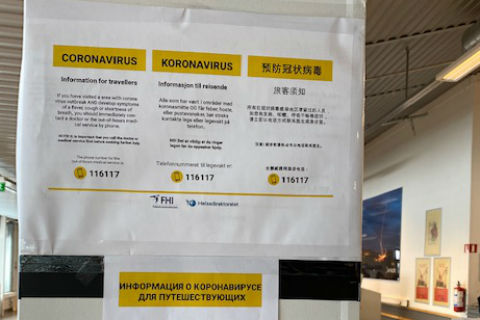
Signs were posted in Kirkenes Airport in Norway, as well as on trains in that country and in Italy. Photo courtesy of the Gill Family.
Q: Your Norway arrangements were made by another WOW List trip designer. What have you been doing in Norway?
A: We spent three nights in Tromso and did this fabulous experience: Vulkana. It’s an old whaling boat that they have remodeled into a spa. On top is the hot tub, a sauna on the second level, and a steam room on the third. And they serve this beautiful lunch and my crazy college daughter, she and everyone on the boat did the polar plunge except me. Not me, no thanks. We saw lots of cruise lines and ships coming in. It seems like they were traveling as usual. I brought masks—just in case we got sick, I didn’t want to get anyone else sick.
We also went on a crab safari. They drive you out to a fjord and they take a snowmobile sled out on the ice and they have drilled a big hole into the thick ice and they just pull the crab baskets out. Then you come back to the house and they cook it, and it was the most amazing crab I’ve ever tasted in my life. Tonight we’re going out to look for the Northern Lights. [Editor’s update: They saw them.]
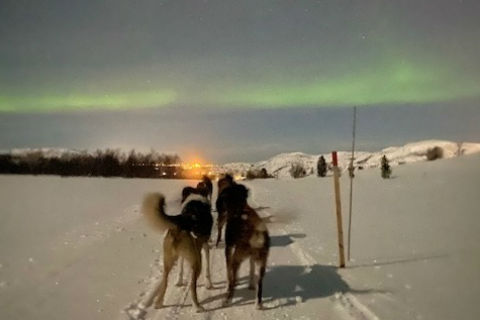
After we spoke, the Gills went on a sled trip hoping to catch the Northern Lights. They found them. Photo courtesy of the Gill Family.
Q: Why Spain and Portugal?
A: We’ve never been to Portugal, it’s not on any travel alert lists, and we like to drink wine. And if you can’t go to Italy…. We thought what the heck. Now, would I go to China? No, because I don’t think they’re as advanced in some of their hygiene and in some of the cities.
Q: How does this trip differ from other trips you’ve taken?
A: It’s the same as other trips, but with more hand sanitizer. We’re not in the at-risk groups. If I was 70 years old or had a compromised immune system, I probably wouldn’t travel—just like if there was an outbreak of flu in my community. But because we’re not in that risk group, I just think life is too short. Before we left, several of our friends said, you’re still going? But the odds of dying on the way to the airport are much higher than me contracting the coronavirus. [Laughs.] That’s how I roll.






